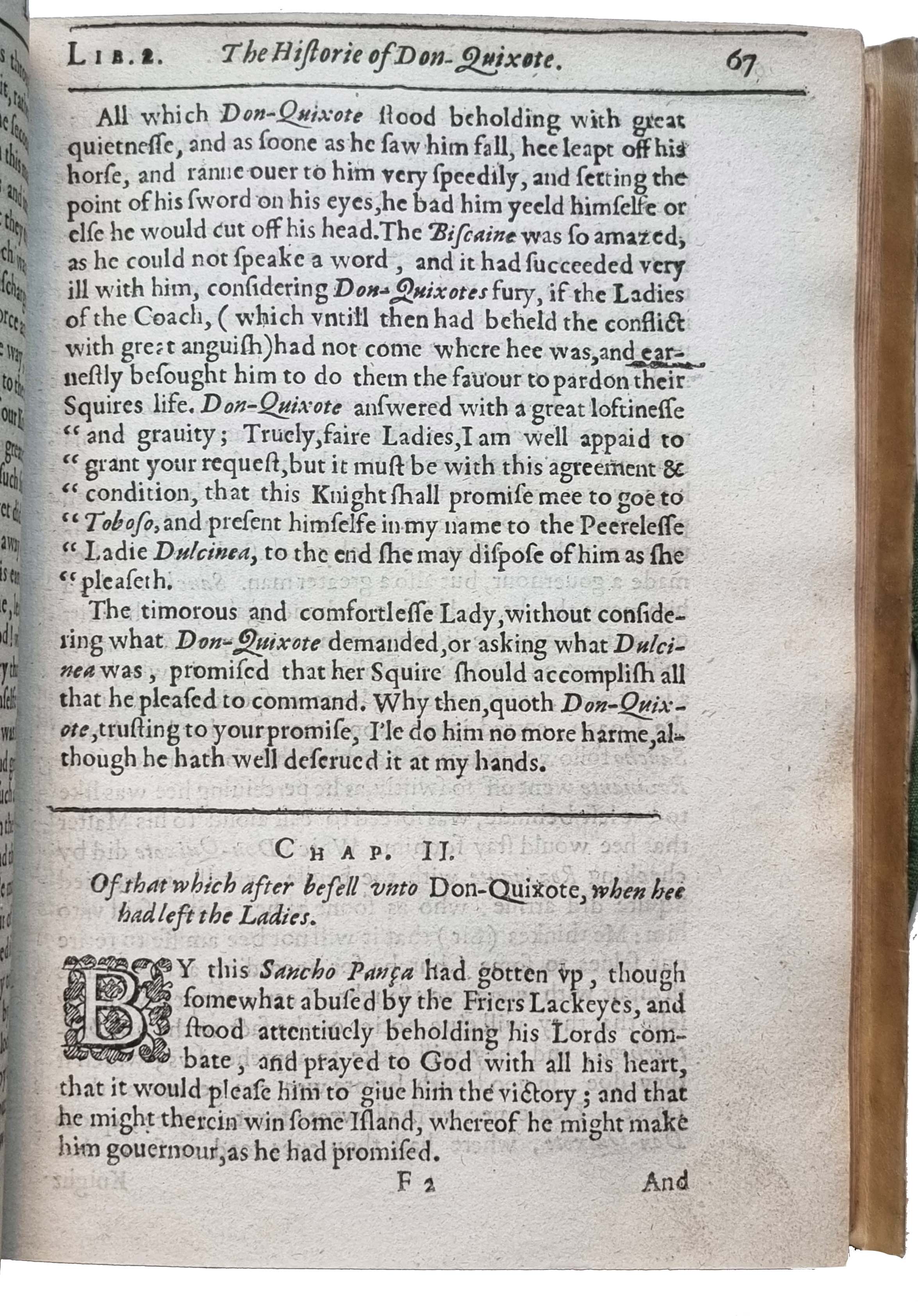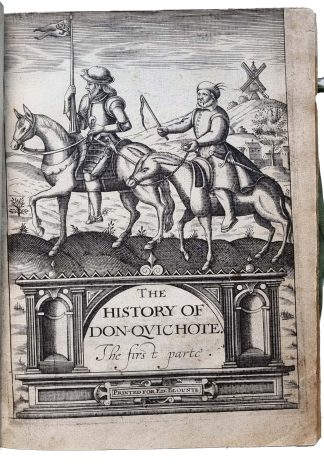CERVANTES SAAVEDRA, Miguel de.
FIRST COMPLETE NOVEL IN ENGLISH
The History of Don Quixote.
London, Printed for Edward Blounte, 1620?, 1620.£97,500.00
FIRST COMPLETE EDITION IN ENGLISH, FIRST EDITION of II. 2 vols. I: pp. [12], 572, [4]; II: [2], [16], 504, lacking final blank. Roman letter, little Italic. Engraved titles with Don Quixote and Sancho Panza on horseback, woodcut vignette to second title, decorated initials and ornaments. Textblock trimmed close at head, occasionally touching typographical ruling, or running title of vol.II, engraved titles and last versos dusty, upper outer corner of P7 (II) torn, affecting two letters, small light water stain to lower outer blank corner of last two ll. (II), the odd minor marginal spot or mark. Very good, fresh and clean copies in modern limp vellum antique by B. Middleton, silk ties, a.e.r., early shelfmark labels preserved at foot of spines, bookplates of Kenneth Rapoport and Michael Curtis Phillips. In folding box.
The first complete edition in English, and the first English edition of Part II, of this ground-breaking literary work – the first modern European novel, rarely found complete, as a uniform set. Attributed to Renold Elstrack, the engraved frontispiece, which reprised the title vignette of the first 1618 French edition, was the illustration of Don Quixote and Sancho to appear in print.
‘“Don Quixote” is one of those universal works which are read by all ages at all times, and there are very few who have not at one time or another felt themselves to be Don Quixote confronting the windmills or Sancho Panza at the inn’ (PMM 111). The epic novel tells the deeds of the minor aristocrat Alonso Quijano, so keen a reader of medieval chivalric romances that he loses his mind (or pretends to), and becomes absorbed in an imaginary world of knightly adventures. After assuming the name ‘Don Quixote’, as a knight-errant, he travels with his witty squire Sancho Panza (a local farmer), facing comic situations he interprets as heroic, including the famous, symbolic and now proverbial fight against windmills. ‘[Cervantes’s] great effects are broad and ample; they spring from the contrasts of incongruous circumstance viewed in the dry light of satiric observation. […] A master on unwinking irony […] a man of genius, a rare contriver of incident’ (Saavedra, p.xxxiii).
Miguel de Cervantes Saavedra (1547-1616) led a picaresque life. He fled Madrid in 1569, after a duel. In Rome, he served Cardinal Acquaviva. He served in the navy throughout the Mediterranean, was at the Battle of Lepanto, and later a prisoner in Constantinople. In 1606, he returned to Madrid, as a tax collector, and eventually joined the Franciscan Third Order. Having written a handful of plays, he published Part I of ‘Don Quixote’ in 1605, followed by Part II in 1615. It was first translated from Castilian into English – the first translation into any language – by the Irish Catholic Thomas Shelton (fl.1604-20) in 1612, using the text of the 1607 edition, printed in Brussels, where Shelton taught Spanish. His enterprise took only 40 days, and immediately influenced English writers, e.g., the lost play ‘Cardenio’ (1612-13), attributed to Fletcher and Shakespeare. The c.1620 Part I is a reprint of Shelton’s text. Previously attributed to Shelton and probably based on the 1615 edition, Part II is now considered to be the work of the Hispanist Leonard Digges (1588-1635). Digges was among the authors of dedicatory poems prefacing Shakespeare’s First Folio, also published by Edward Blount.
The English translation of ‘Quixote’ greatly influenced the language and ideas of English playwrights and poets, including Shakespeare and Jonson. ‘Not merely once but on a variety of occasions the C17 English writers [influenced by ‘Quixote’] reflect and actually participate in the sheer fun of the work by playing with the protagonist’s name. They invent the adjectives “Quixoticall” (1642), “Quixot-like” (1664) […]; the past participle “Don quixoted’ (1658) […]; and the nouns “Don Quichoterie” (1659), “Quixotry” (1665) […]. In short, both the nature and the contagious fun of the character […] were actually adapted, incorporated, and made manifest in fresh English words’ (Randall, pp.xxxvi-xxxvii).
I: STC (2nd ed.), 4917; Pforzheimer, 140; ESTC S107641; PMM 111 (first Spanish ed.). II: STC (2nd ed.), 4917; Pforzheimer, 140; ESTC S107642; PMM 111 (first Spanish ed.). M. Cervantes de Saavedra, The History of Don Quixote of the Mancha, vol. III (1896); D. Randall, Cervantes in seventeenth-century England (2009).In stock






